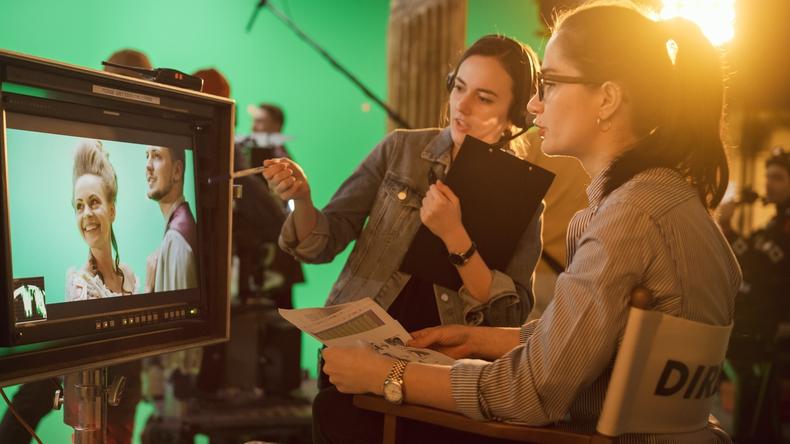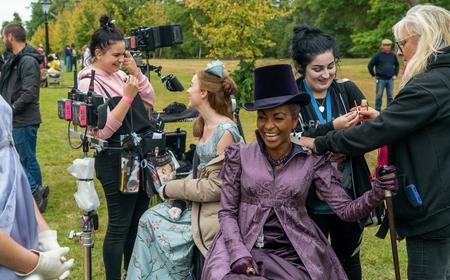
Have you ever watched a movie and wondered: How long did it take to make this thing? The answer to that question depends on a number of factors. Here, we’ll take a look at every element that affects a film’s production time and how long each phase of the process lasts.
JUMP TO
 Featureflash Photo Agency/Kathy Hutchins/Shutterstock
Featureflash Photo Agency/Kathy Hutchins/Shutterstock
Most movies take between one year and two-and-a-half years to complete all three production phases, though there are many variables that can affect this.
While a movie takes only a few hours to watch, it takes years to get that story from concept to finished product. “Filmmaking is a challenge,” says Xavier Luis Salinas, line producer and unit production manager (“Black Water,” “Burning at Both Ends”). “While in production, schedules can change at the turn of a dime, and you have to be ready to pivot right then and there. From the time you develop a script to a shooting script, you are looking at one to three years of your life trying to produce your project.”
The time it takes to film a movie depends on several factors, most notably the budget. Independent movies usually take longer to find funding and get off the ground, but they also have shorter production schedules. Indies can be completed within one year, with as little as one to two months for principal photography (the most expensive part of production). For example: Richard Linklater’s “Dazed and Confused” shot from July 1992 until August 1992. By comparison, Steven Spielberg’s “Jurassic Park” shot that same year from August to November—and that was after 25 months of preproduction.
All film projects are unique, and a film’s requirements directly affect the production timeline.
 Gorodenkoff/Shutterstock
Gorodenkoff/Shutterstock
“There are many reasons that can cause a production to spiral out of control and extend the shoot (and the budget!),” says director, producer, and postproduction coordinator Paul Salamoff (“Starship Troopers 3: Marauder,” “Don’t Look Back”). “I’ve always lived by the mantra that ‘If you fail to plan, then you plan to fail.’ The less prepared a production is before you shoot, the more the unforeseen problems will wreak havoc on the schedule. So, best to spend the time in preproduction when you have less people on the payroll.”
The following is a list of factors that affect movie production length.
- Script length: The general rule is that one script page equals one minute onscreen. Therefore, having a 90-page script will theoretically take less time to produce than a script of 120 pages. The number of individual scenes in a script will also affect production time, as each one requires its own set-ups, shoot days, breakdowns, etc.
- Genre: A film’s genre is usually a good indicator of how long it will take to produce. For example, a comedy requires less time than an action film filled with elaborate stunts, moving vehicles, and pyrotechnics.
- Locations: Different locations require a “company move,” which is when the crew must pack the equipment and props, travel to another location, and set up the area for filming. The more locations in a script, the more company moves—which means more time needed to film the movie.
- Night scenes vs. day scenes: Night scenes take longer to film because more lighting is required. The director of photography and his crew will need more time to prepare the set and take down equipment after filming wraps.
- Cast: The more actors you have in a scene, the longer it will take to get everyone to their places before each take. The director will also need more coverage of each principal actor’s performance.
- Stunts: Safety measures must be strictly followed, so there’s no way to quickly capture stunts. Moving vehicles also require a lot of preparation, including closing down streets if you’re in a city. Overall, large-scale action scenes will increase the number of necessary crew, lights, cameras, and riggings.
- Child actors: Local laws limit the amount of time child actors can be on set; those restrictions compound over the course of an entire production, adding more time to the overall shoot.
- Animals: Even though any animal on set will be trained, it will still be harder to get them exactly within the frame, on blocking, and reacting to their environment than it would with a human actor.
- Weather: Weather conditions can change without warning and delay production when filming exterior shots. This can also add up after you wrap for the day. For instance, if you start filming a scene on a sunny afternoon but don’t capture all your coverage, you will have to wait until a similarly sunny afternoon to finish the scene.
- Contingencies: Of course, there are the limitless possibilities that can’t be planned for, such as equipment failure, talent schedule changes, and even a situation such as the COVID-19 pandemic, which halted all production in 2020 and early 2021.
 John Dvorak/Shutterstock
John Dvorak/Shutterstock
Development
The amount of time it takes to develop a film is the most variable of all phases; some scripts take years to find funding and talent. Although no actual production happens during this phase, it is where the plans for a movie take shape. Producers assess a script to determine the budget, considering factors such as the genre, the amount of actors and shooting days required, and the extent of visual effects.
Preproduction
Preproduction can take three to six months, depending on the budget and scope of the film. Movies that require more locations and sets will remain in preproduction longer.
During the preproduction stage, all necessary preparations for principal photography are put into place, including scouting locations, building sets, and hiring crew members.
Production
Production (or principal photography) for a mid-range movie can last around “five to eight weeks, with lower budget ones as little as three to four weeks,” says Salamoff. “Basically, the more money you have the longer you get to play.”
Postproduction
The postproduction process takes between six months to a year to complete. Movies that require a high amount of visual effects will always remain in postproduction longer.
Summing up the time for all three production phases after development, the average time to make a movie is between one and two-and-a-half years. But remember, each film will always contain specific factors that shorten or increase the length of production.
 Film Crew Hierarchy: A Guide to Every Job on a Movie Set
Film Crew Hierarchy: A Guide to Every Job on a Movie Set  The Stages of Film Production: From Script to Marketing
The Stages of Film Production: From Script to Marketing